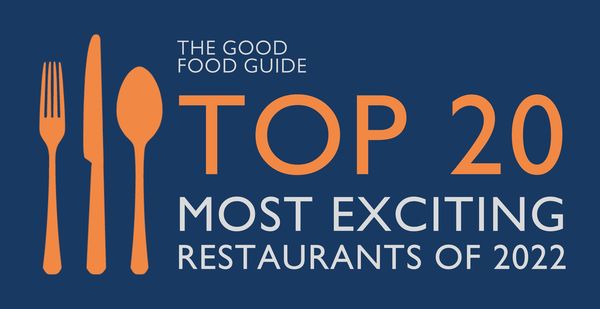Le Manoir aux Quat’Saisons stormed into the 1985 edition, with Raymond Blanc declared the ‘champion of a new era’ and hailed as Chef of the Year: ‘Blanc is completely self-taught. He came to England only because he wanted to be a waiter and needed another language. The local restaurant at Besançon had told him he was too old at 20 to start in the kitchen - that restaurateur must be kicking himself today - and Blanc only started cooking because his girlfriend’s hotelier father suddenly found himself without a cook at the beginning of the season.'
The Good Food Guide 1983
This will probably be Raymond Blanc’s last year in his ordinary-looking shop in the precinct. And a good thing too. The neighbouring chip shop, the Dewrop pub, the Oxfam shop, the cluttering of young mothers with babies, his own bakery down the road which persuaded Oxford that the prices in the Quat'Saisons were not beyond them (yes, there is a lot of money in this part of Oxford now) have been good companions but this beautiful restaurant has outgrown its shop which was probably originally thought of as a launderette for foreign students. It is time to let the launderette come back. The country house he is moving to in Botley Road some time this summer will be more in keeping.
Like Michel Guérard's his cooking deserves a mansion with two-hundred-year-old trees outside, or - like Albert Roux- he could have considered a move to Mayfair. If Blanc trips of an evening it is not because of a lack of inspiration or imagination but because of the constraints around him. There were odd reports early last winter that he had hit problems, though these were scotched by superlatives again in summer. Comparisons of great chefs should not really be qualitative ones, for after a certain point individuals move into their own territories and force back new frontiers, and Blanc should now - after being seriously established here for a mere five years - cut loose.
The Guide file is fat with contented diners' reports. There is a grump here - about prices, naturally - and there - about waits between courses, another chestnut - but not a murmur of disapproval of the food. One visitor was ready to walk straight back inside after lunch and start all over again. If you have money in Oxford to spend on restaurants, and there is plenty of competition, sooner or later you should spend it here.
After a mix-up one customer waited an hour for his food to arrive. ‘I was in such a bad mood that I was in a super-critical temper. The first smell and mouthfuls disarmed me.'
There is a tantalising moment, far too fleeting, when the dishes are presented at the table, brilliantly decorative, and the smells that rise up and hit you should be hung onto and savoured. Occasionally it can be a sadness to eat such a beautiful creation, so powerful are sight and scent but the lure is uncompromising. But also there is a feeling that Blanc should abandon the usual luxuries of oysters (a strong point in themselves served au naturel or poached in wine on a bed of spinach and watercress mousse, served with a butter and chive sauce with cucumber julienne) and salmon so clichéed in restaurants and concentrate on those flavours that are familiarly found in home cooking because he can make the ordinary extraordinary. Dealing with the exotic can take him out of the orbit of the everyday palate. The brilliant simplicity of the Jerusalem artichoke mousse with an asparagus coulis or a light scallop salad can be devastating enough. His skill is in simplicity and he has so far shunned, perhaps because he has had no formal training, the complex mutations offered in other establishments where gourmets are presented with a Call My Bluff quiz show of ingredients.
The menu evolves around the seasons (hence the restaurant's name), and the three-course lunches (£10.50, but watch the £1 cover charge and the £1.30 coffee) are more in the simple vein - artichoke hearts cooked in wine with coriander and lemon thyme, then either duck thighs with herbs or scallops in a vermouth sauce on a bed of spinach leaves, and marquise au chocolat. The nibbles before and the petits fours might be bettered but are served to the converted. The service can be arrogant and offhand in the manner of nationalised industries. Raymond Blanc comes out of the kitchen after the meal to cross-examine customers zealously, which may please gourmets but would be upsetting if you were proposing. Malvern water is on the table. The Quat'Saisons insignia has been engraved on the wine glasses. The bench tables are probably more relaxing than being out in the main area.
There is no easy advice for finding wines to match such food and perhaps there is a case for choosing something not too spectacular so that it will not distract. There would be little harm in such caution with house French at £6.50 except that the list itself is not to be cold-shouldered. A powerful selection of nearly 50 burgundies rise from the Mâcon-Prissé '79 from Georges Duboeuf at £8.80 to La Tâche '69, Domaine de la Romanée-Conti at £85. There are plenty of '78s and some '79s in the whites which could be investigated now. Muscadet at £8 is not cheap and Sancerre les Princesses from the same year is £10.50. Clarets are listed in districts and offer four '61s…at a price. The St Emilions, for example, run through Ch. Monlot Capet '76 at £10, Ch, Jacques Blanc '74 at £9.80, Ch. Cheval Blanc '67 at £35 and Ch. Trottevieille '57 at £30. But there are twenty house recommendations and Beaujolais listed under £10. Armagnacs go back to Janneau '39 at £4 a glass and there is a choice of four calvados, three marcs and three vintage cognacs. Go on, have an Otard ’52 at £4.75 once in a while.
The Good Food Guide 1986
The Manoir is a sensation. To quote from just one report from the correspondents who wrote last year: ‘No restaurant will ever be quite the same again – the dishes were exquisite, the portions not big, but we left the table completely satisfied […] Raymond Blanc has, miraculously, appeased the money men, ironed out the stiffness in the service and put the kitchen into overdrive. Some of the cooking is simply amazing.
The Good Food Guide 1987
It is a testimony to Raymond Blanc’s cooking that despite the expense of eating here, the Guide has sixty-two recommendations for different dishes that reporters have eaten at Le Manoir in the past year. Coffee with petits fours at an astonishing £3 claims seven specific endorsements. Even the French guidebook Gault/Millau has finally rumbled what we have known since the late 1970s – that Blanc’s is no ordinary talent. The restaurant's main weakness at present is that it lacks consistency: occasionally, dishes are not of the level of the rest of the repertoire. But these are exceptions in what has become an extraordinary procession of creativity, passion, subtlety, indeed genius, which comes out of the electrically operated kitchen doors. Eating at Le Manoir is like eating in the future.
Take, for example, new season’s lamb with a mild curry and basil sauce. Or partridge and duck with a veal sauce. Or salmon and turbot steamed in cabbage leaves. All this is served with grace and good humour in the elegant pink dining room of the aristocratic house, which has equally elegant grounds and garden. The emphasis is on dramatic presentation; the now often plagiarised salmon tartare – the opening trademark of the move from Oxford to this old village – wrapped up in cucumber and crowned with caviar, is one end of the spectrum that extends right through to a virtually bourgeois and very rich amalgam of fried foie gras with pigs’ trotters stuffed with veal sweetbreads and lamb’s tongues. Fish draws thunderous applause – the red mullet fillets pan-fried with pistou and the sauce of veal stock with more basil. Among the many sweets commended are coconut soufflé, apple mille-feuille, and peach in Sauternes.
There is more, much more. One meal may be a temptation to return for another, but, alas, the wine list assists in making this more difficult. Following our criticism last year, at least there is now Gaillac Perlé at £9.60 - £4.50 cheaper than the house Sancerre. Otherwise, the wine prices are what you would find in France. Three figures for Drouhin’s Musigny may be justified because it is a ’49, but credibility is stretched as much as the pocket with a £118 tag for Bonneau du Martray’s undoubtedly first-rate ’78 Corton Charlemagne. Both négociants and growers provide the Burgundies, and the vintage spread of clarets is impressive with all the big names here. But Ch. La Cardonne ’78 is one of the few under £20. Côres de Buzet ’82 Cuvée Napoléon is relatively inexpensive alternative to red Bordeaux at £11.65. Sweet teeth are indulged with good Barsac, and Jaboulet dominates the Rhône. N.B. John Burton Race has left Le Petit Blanc (61 Banbury Road, Oxford) which is why we have had to exclude this Blanc-owned restaurant from the Guide. The new chef, Bruno Loubet, has however, been rated highly in previous Guides, when he was at Gastronome One (London).
The Good Food Guide will be returning this spring, click here to register for early access








